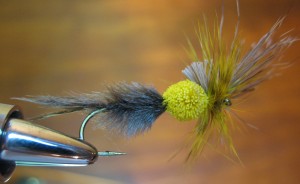Hexagenia Cripple
Hook: Daiichi 1720 #6
Tail/Body: Natural Ostrich Herl
Thorax: Yellow Deer Hair (spun)
Wing: Natural Deer Hair
Hackle: Yellow Grizzly
Thread: Yellow or Grey
If one was to create a Washington State fly fishing bucket list, fishing the hex hatch on Merrill Lake would surely be on such a list. The opportunity to throw size 4 dry fly patterns at big browns is a thrill in and of itself. Doing so in total darkness adds certain uniqueness to the experience that makes it a must do trip.
The peculiarity of the Merrill Lake hex hatch has fostered a sort of “cult following”, where hearty (or maybe misguided) souls meet at the boat launch just before dusk. Here they will exchange small talk, maybe a pattern or two, then head out on their float tubes, pontoon boats and car toppers to find a spot on the lake and wait for the darkness to fill in the landscape. As the sun drops below the horizon, one of the biggest of all mayflies, Hexagenia limbata, start coming off the water.
Brown trout emboldened by the cover of darkness and 2 inch long protein snacks emerging on the surface, throw caution to the wind and will take imitations readily. One great imitation to use is a Hexagenia cripple.
This pattern is based on a standard mayfly cripple pattern like the Quigley’s Cripple. This pattern is designed to look like an emerging mayfly or one that is sort of stuck between phases and has either died or will shortly here after, (hence the name cripple). Sometimes trout key in on these “crippled” mayflies because they are a guaranteed meal. Using a cripple pattern can be very effective especially during a heavy hatch.
To tie this fly, start by creating a tail with the ends of 2 ostrich herls. A good trick is to leave your thread at the tail tie-in point, then palmer the herl up the shaft and then wrap the thread through the herl to reinforce it. The thorax is spun deer hair. Spinning deer hair is definitely a more technical technique but not impossible. Get a book or do a little searching on the internet and you should be able to find enough instruction to get you on your way.
Here you will want to tie your thread off and trim your deer hair to the shape you want, then tie your thread back on and finish the fly with the deer hair wing and a few wraps of hackle.
When on the water only the hackle and wing should be dressed with floatant. This fly is made to sit almost vertical in the water, and it doesn’t hurt for it to sink a few inches.
Tie a few for your box and enjoy. Don’t forget to bring a head lamp.


